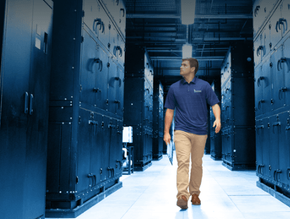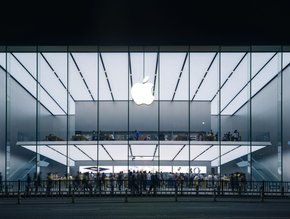Leading Edge: At the edge of digital evolution

There’s no doubt that leaders in the data centre sphere are pioneering once unfathomable and life-changing developments as the industry continuously evolves, and Leading Edge Data Centres is no different.
Its Founder and CEO, Chris Thorpe, is at the forefront of tackling the ever-growing challenge of digital equity across Australia. With a network of six data centres across New South Wales with a further 13 facilities in the rest of Australia — one of the world’s largest countries by area — Thorpe and Leading Edge have a vision to provide equal access to connectivity regardless of their geography.
Connectivity: Regional Australia’s biggest region challenge
“We want to provide experience that you get in metropolitan environments like Sydney and Melbourne and take that to the regions so they get the same experience,” Thorpe says, explaining that the biggest challenge in regional Australia is connectivity. “So if you can actually take the compute environment with its high sustainability and high resilience so you still get the cybersecurity, you've got on the whole a very similar experience, but in a smaller environment. If you can take that to the regional environment, they’ll be on the same level playing field. That is the key.
“It's about building the platform so regional areas can compete in the same environment as metropolitan and again, really compete on a global stage as the metropolitan environments do.”
Founded just before Covid when restrictions were enforced on Australia, Leading Edge faced the challenges of finding its feet, and worked with pioneering partners such as Schneider Electric to form a solid foundation.
“You've got major data centres in the metropolitan locations,” Thorpe explains. “We are not trying to compete in those environments. What we're trying to establish is a secure, resilient environment in regional locations directly connected back into the core, which is great for disaster recovery and compute. You need it locally, you need it fast, secure and in an environment that’s got some serious uptime.”
Thorpe highlights how in his experience, regional locations lag behind that of urban geographies when it comes to technical advancements, sometimes by up to 10 to 20 years. This, he says, is what sets Leading Edge apart from competitors, while also highlighting how operators need to work together to ensure equity as a common goal.
“Rural areas struggle to reach the cloud with a very high level of resilience. If you can actually locate it close to them, they're not paying for that expensive backhaul pipe. There are many different factors. You can access the cloud in an environment very close to you. If your business is actually totally dependent on a backhaul environment going back to Sydney or back to Melbourne and an issue happens, your business fails. So edge facilities just take all those issues away.”
Building fundamental infrastructure
Essentially, Chris and the Leading Edge team are laying the foundations for fundamental infrastructure to support the current need for connectivity as well as new applications on the horizon. Now boasting a growing ecosystem of 40 clients, Leading Edge is helping its clientele realise the opportunity ahead of them in providing essential services to businesses across Australia, regardless of their location.
And, thanks to Leading Edge’s disaster recovery credentials, CCTV quality and applications, it has seen advanced manufacturing businesses coming aboard.
“We are reducing telco costs by between 50% and 60% and increasing their speed by five times,” he says, proudly. “Their resilience just goes through the roof. We've got case studies where businesses have been struggling to grow because they can't compete with metropolitan areas, but now they're connected with us, they’re reducing their cost and increasing their speed and resilience. They're now actually recruiting people and their business is back into growth mode.”
Harnessing the natural landscape
Rural Australia's harsh landscape adds an extra challenge to levelling out digital equity, but Thorpe and Leading Edge, from the offset, have chosen to leverage this to their advantage rather than see it as an obstacle.
“Regional Australia is really harsh,” Thorpe demonstrates. “You can have extremely hot and extremely cold environments as well as drought and floods. So we needed to design an infrastructure that was going to be able to cope with all of those environments, plus be sustainable.”
With this in mind, Leading Edge, in collaboration with Schneider Electric, constructed a modular-style data centre in New South Wales armed with a solar shield over the top to protect the facility from the arid landscape and harness the sun’s rays.
“The building below is completely protected from the elements,” Thorpe shares. “As well as covering the roof in solar, we've got lightning conductors on the roof and a two end environment, so we have multiple layers of redundancy for power and cooling.”
The facility can also run off-grid in the case of loss of power: a common occurrence in rural Australia thanks to frequent storms and a contributor to the ongoing digital inequality.
“There’s one site in particular, Tamworth,” Thorpe explains, “where we've lost power on five occasions for up to four or five hours. The system has been tested on multiple occasions and we have 100% uptime across the network to keep the data centres up and running. What we've built is highly resilient.”
The facility is a 50-year certified structure and despite the technology inside being bound to change over time, its long-term sustainability credentials ensure it can be hooked up to renewable power quickly in the not-so-distant future when it is less of a premium.
“We're operating in regional Australia and it’s beautiful, but it can be extremely harsh. Operating a 24/7 resilient data centre infrastructure has serious challenges, which is why we've built with a kind of a bunker-style, government-grade mentality.”
AI and the ever-changing edge landscape
And with connecting rural locations with the same speed, latency and general connectivity as metropolitan areas, Leading Edge’s edge facilities are equipped to handle future-centric dominating technologies.
“AI is interesting, I've seen the impact on the hyperscale market in Sydney already,” Thorpe details. “I see positive pressure, and AI will live on and drive the edge in many ways. Let's just see how this transpires.”
Citing the US and Europe as leading markets advancing in the edge environment, Thorpe looks ahead to what is coming Australia’s way. “Everything's generating data now,” he adds. “Everything is becoming a digital twin, so that data needs to be processed close because the volumes we're talking about are going through the roof.”
Advocating that Leading Edge’s facilities are part of the building of regional infrastructure that Thorpe feels should have been built 15 years ago, he envisions a much wider-scale roadmap.
“You look at autonomous vehicles — anything on the ground or in the sky — we're talking agriculture, a numerous number of industries that are affected by AI. You need close to zero latency environments to be able to facilitate that — we're initially building a mesh network of across 3,000 kilometres to support that.
“It's actually very encouraging from our perspective, because we've put our foot forward and led the market here in Australia.”







